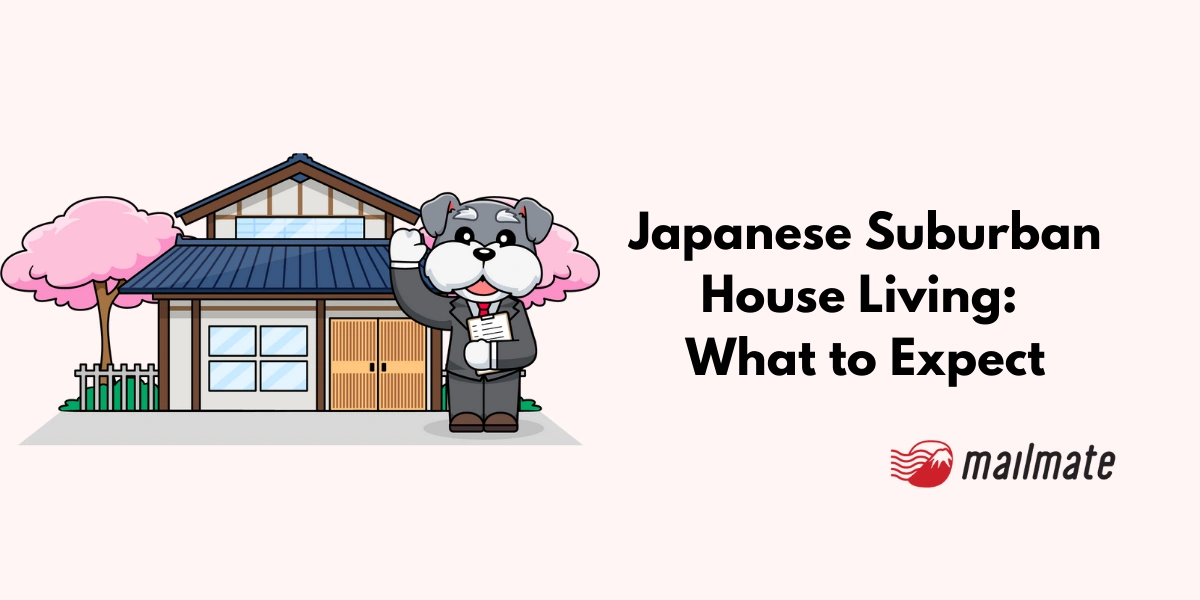Japanese Suburban House Living: What to Expect

Living in Japanese suburbs offers a unique blend of modern convenience and traditional culture that differs significantly from Western suburban experiences.
This comprehensive guide covers everything potential residents need to know about owning or renting a suburban home in Japan, from practical costs to cultural considerations.
Whether you're an expat considering a move, a foreign investor exploring real estate options, or simply curious about Japanese residential life, this guide provides the detailed information you need to make informed decisions.
What are the Japanese suburbs called?
Japanese suburbs are called 近郊 (kōgai), referring to residential areas on the outskirts of major cities. These areas are also sometimes called 住宅地 (jūtakuchi), meaning "residential districts."
Japanese suburbs vs Japanese countryside: key differences
The Japanese suburbs are residential areas outside major cities that balance the city and the countryside well. Most houses are single-family houses with good access to public transportation.
Suburban areas in Japan are quieter than living closer to the city center, but still with access to urban amenities.
On the other hand, the Japanese countryside, also called inaka, is much further away from urban areas. It is known for its natural landscape, more traditional house architecture, and slower pace of life.
Countryside homes are much larger, have limited amenities and services, and residents mostly rely on cars for traveling.
Here is a table comparing the key differences between Japanese suburbs (近郊 - kōgai) and the countryside (田舎 - inaka):
Feature |
Japanese Suburbs (近郊 - kōgai) |
Japanese Countryside (田舎 - inaka) |
Location |
30–60 minutes by train from city centers |
1+ hours from major cities |
Population Density |
2,000–5,000 people per km² |
Under 1,000 people per km² |
Housing Type |
Mix of single-family homes and low-rise apartments |
Mostly single-family homes with larger lots |
Public Transportation |
Regular trains every 10–15 minutes during peak hours |
Infrequent buses every 1–2 hours |
Access to Amenities |
Walkable access to convenience stores, schools, etc. |
Car required for access to daily necessities |
Car Ownership |
Often optional |
Essential |
Japanese suburban house designs and floor plans, explained

Suburban Japanese house plan | Mac Atelier
Unlike Western suburbs with standardized layouts, Japanese suburban homes feature highly customized designs adapted to small, often irregularly-shaped lots averaging 100-150 square meters (1,075-1,615 square feet).
In general, new houses in Japan are relatively affordable and easy to build. As a result, they are often not designed to last for generations, tend to occupy smaller or irregularly shaped lots, and frequently feature unique architectural designs.
Despite this, many Japanese homeowners make the most of these conditions by building custom homes tailored to their needs. Most new houses incorporate modern earthquake-resistant materials to meet current safety standards.
A typical suburban Japanese house has a layout similar to that of an apartment but with more space and sometimes an additional floor. Common features include a dining area, a living room, and extra storage. Depending on when the house was built, it may include a mix of Japanese-style and Western-style rooms. The presence of tatami mats is usually a clear indicator of traditional Japanese rooms.
Common layout features
LDK (Living-Dining-Kitchen): The main living space combining all three functions in one open area, typically 12-20 tatami mats in size
Separate bedrooms: Usually 6-8 tatami mats each
Washitsu (Japanese-style room): Traditional room with tatami flooring, present in 60% of suburban homes
Genkan: Entrance area for removing shoes, essential in all Japanese homes
Unique architectural elements
No basements: Japanese homes rarely have basements due to:
High earthquake risk requiring flexible foundations
High water table in many areas
Humidity and mold prevention
Integrated parking: Most homes include a small parking space within the property footprint rather than a separate garage, typically accommodating one compact car.
Multipurpose balconies: Second-floor balconies serve primarily as outdoor laundry drying areas, with retractable covers for rain protection.
Earthquake-resistant construction: Homes built after 1981 include:
Flexible wooden frame construction
Reinforced concrete foundations
Shock-absorbing materials between floors
Note: It's rare to see a guest house or guest room in a Japanese suburban house.
The suburban lifestyle: what to expect daily

The Japanese suburbs might look different from your home country's suburbia. Here, we explain what makes a Japanese suburb a Japanese suburb.
1. No on-street parking
Japan prohibits on-street parking in most residential areas. Car owners must prove they have private parking before purchasing a vehicle, contributing to:
Cleaner, more pedestrian-friendly streets
Increased walking and cycling
Quieter neighborhoods with less traffic noise
2. Narrow roads and careful driving
Japanese roads are narrower compared to the West. Because of the narrowness, drivers are more cautious and tend to drive slower.
That adds another level of safety and quietness to these Japanese suburbs.
Slower vehicle speeds (20-30 km/h in residential areas)
More cautious driving behavior
Increased safety for pedestrians and cyclists
3. Compact and unique house designs
Many Japanese homes have been customized to their owner's preference, making each house look very visually different from North American suburbs, where many neighborhoods look visually similar.
Additionally, due to Japan's location, many suburban homes are built with earthquake resilient materials such as reinforced concrete, flexible wooden buildings, and other construction techniques for safety without sacrificing aesthetics.
It's also common to see apartment buildings next to houses due to Japan's unique zoning laws. Japanese zoning laws allow mixed residential and commercial use, creating neighborhoods where:
Convenience stores sit next to houses
Small restaurants operate on residential streets
Apartment buildings neighbor single-family homes
Schools, clinics, and shops remain within 500-800 meters of most homes
4. Convenient amenities close by
Many Japanese suburban areas have amenities like groceries, pharmacies, schools, and convenience stores nearby that are within walking or biking distance.
They'll also have public transportation that allows them in and out of the city if needed.
Unlike in North American suburbs, driving is not necessary in these Japanese suburbs. However, that doesn't stop people from owning one.
Most suburban areas provide:
Convenience stores: 7-Eleven, Lawson, or FamilyMart within 300 meters
Supermarkets: Full grocery stores within 1 kilometer
Elementary schools: Within 500 meters (children walk to school)
Train stations: Within 1-2 kilometers with bus connections
Practical considerations and costs
Understanding the financial realities of Japanese suburban living is crucial for making informed decisions about relocation or investment.
Beyond the initial purchase or rental costs, suburban homeowners face ongoing expenses that can vary significantly depending on location, home age, and lifestyle choices.
Japanese utility systems, tax structures, and community obligations operate differently from Western countries, often requiring foreign residents to adapt their budgeting approaches.
The following breakdown covers both one-time costs associated with acquiring a suburban home and the monthly expenses you can expect as a long-term resident.
Housing costs by region (2024 data)
Purchase prices for 3-bedroom suburban homes:
Tokyo suburbs: ¥35-50 million ($260,000-370,000 USD)
Osaka suburbs: ¥25-35 million ($185,000-260,000 USD)
Nagoya suburbs: ¥20-30 million ($150,000-220,000 USD)
Monthly rental costs:
Tokyo suburbs: ¥120,000-180,000 ($890-1,330 USD)
Osaka suburbs: ¥80,000-120,000 ($590-890 USD)
Nagoya suburbs: ¥70,000-100,000 ($520-740 USD)
Monthly living expenses
Utilities (electricity, gas, water): ¥15,000-25,000 ($110-185 USD)
Internet: ¥4,000-6,000 ($30-45 USD)
Waste disposal: ¥0-2,000 ($0-15 USD) - varies by municipality
Community fees (if applicable): ¥2,000-5,000 ($15-37 USD)
Waste disposal and recycling
Japanese suburbs require strict waste separation:
Burnable waste: 2-3 times per week
Non-burnable waste: 1-2 times per month
Recyclables: Separate collections for paper, plastic, glass, and metals
Large items: Special pickup requiring advance scheduling and fees
Frequently asked questions
Can foreigners buy houses in Japanese suburbs?
Yes, foreigners can purchase property in Japan without residency requirements. However, obtaining a mortgage typically requires permanent residency or a stable long-term visa. Many foreign buyers purchase properties outright or through cash transactions.
How long does it take to commute from suburbs to city centers?
Most Japanese suburbs are designed with commuter convenience in mind. Expect 30–60 minutes by train to reach major city centers during peak hours. Express trains and multiple route options often make suburban commuting faster and more reliable than driving.
Do I need to speak Japanese to live in Japanese suburbs?
While basic Japanese is helpful for daily interactions with neighbors and local services, many suburban areas near major cities have some English-speaking services. However, dealing with utilities, local government, and community meetings typically requires Japanese language skills or assistance.
What does "LDK" mean in house listings?
LDK stands for Living-Dining-Kitchen, indicating an open-plan space that combines all three functions. The number before LDK (like "3LDK") shows the number of separate bedrooms plus the main living area. For example, 3LDK means three bedrooms plus one combined living-dining-kitchen space.
Are Japanese suburban houses cold in winter?
Traditional Japanese homes can be quite cold due to minimal insulation and heating only specific rooms rather than the entire house. However, newer suburban homes often include better insulation and modern heating systems. Expect to heat individual rooms with air conditioning units or kerosene heaters.
Can I park on the street temporarily for deliveries or guests?
Street parking is prohibited in most suburban areas, even temporarily. Delivery drivers typically use designated spots or private driveways briefly. For guests, you’ll need to direct them to nearby paid parking or consider homes with multiple parking spaces if you entertain frequently.
Is it worth owning a car in Japanese suburbs?
Car ownership depends on your specific location and lifestyle. Many suburban areas have excellent public transportation, making cars optional. However, cars provide convenience for shopping, family outings, and accessing areas beyond train networks. Consider the parking requirements and costs before deciding.
How do emergency services reach homes on narrow roads?
Japanese emergency services use smaller, specialized vehicles designed for narrow residential streets. Fire trucks, ambulances, and police vehicles are typically more compact than Western equivalents. Building codes ensure emergency access requirements are met even on the narrowest roads.
In closing
Owning a Japanese suburban house offers a mix of modern and traditional living that's very different if you are used to living in the suburbs of North America.
For those seeking affordable housing with good city access, strong community ties, and the opportunity to experience authentic Japanese residential life, the suburbs provide an excellent option. However, prospective residents should carefully consider their tolerance for longer commutes, limited English-language services, and the effort required to integrate into Japanese community life.
The investment in time and cultural adaptation typically pays off with a high quality of life, safety, and the unique experience of living as part of a Japanese neighborhood community.
Spending too long figuring out your Japanese mail?
Virtual mail + translation services start at 3800 per month. 30-day money-back guarantee.

